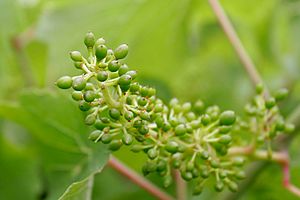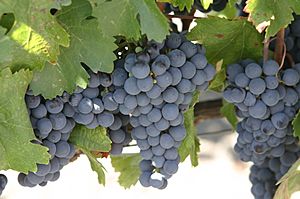Coulure facts for kids
Coulure (say 'koo-LYUR') is a problem for grapevines. It happens when tiny grape flowers don't turn into grapes. This often occurs because of bad weather during a key time for the vine. In English, some people call this problem "shatter."
Cold, cloudy, or rainy weather can cause coulure. Very hot weather at the wrong time can also trigger it. This problem usually shows up in the spring. Vines that don't have enough sugar in their parts can also get it. The tiny grape flowers stay closed and don't get pollinated. This means no grapes grow, and the flowers just fall off.
Coulure can also make grape bunches look uneven. These loose bunches can get sick more easily. A grapevine with coulure will produce much fewer grapes. Some grape types are more likely to get coulure. These include Grenache, Malbec, Merlot, and Muscat Ottonel. Other things can also cause coulure. These include pruning vines too early or too much. Very rich soil or too much fertilizer can also be a cause. Choosing the wrong plant parts for the vine can also lead to it.
During the grapevines' growing season, especially when flowers bloom, they need good weather. This means dry conditions with enough sunlight. The air temperature should be around 15 degrees Celsius (59 degrees Fahrenheit). If the weather isn't good, like if it's wet and rainy, more flowers might not get pollinated. This increases the chance of coulure happening.
Coulure is different from another grape problem called millerandage. With millerandage, the flowers are pollinated, but the grapes grow without seeds and stay small. Both coulure and millerandage can be caused by bad weather when flowers bloom. Both also lead to fewer grapes being produced.
Why Coulure Happens
Coulure happens because the grapevine doesn't have enough carbohydrates. Carbohydrates are like the plant's energy food. When there isn't enough, the vine saves its energy. It stops sending resources to the tiny grapes that are trying to grow.
After flowering, if carbohydrate levels drop, the small stems connected to the berries dry up. The tiny grapes, about 5 millimeters (0.2 inches) across, then fall off.
It's normal for a vine to drop some fruit. This helps the vine manage its energy and how many grapes it produces. But when bad weather makes the problem worse, coulure can greatly reduce the number of grapes. This can affect how many grapes are available and their price.
When weather is the main reason for coulure, it's called coulure climatique in French. This means cloudy and wet conditions. These conditions limit how much sunlight the vine gets. Sunlight is needed for a process called photosynthesis. Photosynthesis is how plants make sugar for energy. Less sunshine means lower sugar levels. This means fewer resources to help the grape berries grow.
Warm temperatures can also make coulure worse for some grape types. This is because warm weather can make the vine use up more energy. It can also cause too much new shoot growth. These new shoots compete with the grapes for the vine's energy. Other things that can cause coulure include very rich soil. This can be natural soil or soil with too much nitrogen fertilizer. Using very strong rootstocks or pruning the vine too much can also cause it. Pruning too much means there aren't enough leaves to make energy through photosynthesis.
How to Prevent Coulure
You can't stop coulure completely, but grape growers can take steps to make it less severe. Some grape types are more likely to get coulure. These include Grenache, Malbec, Merlot, and Muscat Ottonel.
Growers can choose to plant special versions of these grapes, called clones. Newer clones of Merlot and Malbec are less likely to get coulure. In the vineyard, growers can be careful not to prune too much. They make sure there are enough leaves for the vine to make energy. Trimming the tips of new shoots can also help. This is done near the end of the flowering time. It helps make sure the grapes get enough sugar, not the new shoots. For vineyards that don't use organic viticulture, special chemicals can be used. These chemicals help limit how much the shoots grow.




